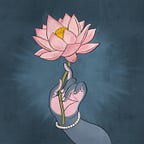The Kapi-dhvaja
The Hanuma-dhvaja or kapi-dhvaja, the monkey standard, was a widely known dhvaja in ancient india. According to the Mahābhārata, the kapi-dhvaja was created by Prajāpati after a long penance. It was borne by King Soma during his exploits over demons who then passed it to Varuṇa. Varuṇa gave it to Arjuna upon Agni’s request. This adds to the significance of Agni as a parivāra-devata who is also described as bearing the kapi-dhvaja. Hanumān standards were also used by Harihara I and Bukka I, the founding kings of Vijayanagara empire, in the fourteenth century. The staff of the dhvaja was gold, surmounted by the divine Vānara animated by a ferocious expression.
There were beliefs and portents associated with the use of the dhvaja in war — such as the trembling of the dhvaja being an ill omen and the fall of the dhvaja from the chariot being a sign of impending doom. An auspicious dhvaja was blessed with certain attributes and assured victory to the bearer. In this respect, the kapidhvaja was considered the ideal. The kapi-dhvaja is also called a jaya-dhvaja and was a harbinger of victory in war. To Arjuna, the kapidhvaja played a role in blessing the bearer with victory on the battlefield.
Ancient Indian ethics of war did not permit attack on an enemy who had surrendered and was incapable of defending his dhvaja and weapons. The submission of one’s standard was a sign of surrender. The value of the standard was a distinguishing mark of the warrior. Warriors would raise their standards before marching into the battlefield. In the Mahābhārata, among the Pāṇḍava warriors, Arjuna displayed the kapi- or vānara dhvaja, Yudhiṣṭhira a pair of Mṛdaṅga, Bhīma a siṃha, Nakula a śarabha, Sahadeva a haṃsa symbol on their standards. Abhimanyu chose the bird śāraṅga, the five sons of Draupadi the images of Dharma, Vāyu, Indra and Aśvini-kumāra, Dhṛṣṭadyumna a Kovidāra and Ghaṭotakaca as a gṛddha as their dhvaja symbols. Among the Kauravas, Duryodhana displayed on his standard a serpent, Bhīṣma a tāla, Droṇa an altar covered with deer skin and a kamaṇḍalu, Karṇa an elephant chain, Kṛpācārya a bull, and Aśvatthāma a lion-tail.
Arjuna fighting for Virāṭa against the Kauravas, raised his glorious Kapi-dhvaja before going war. He did this even though the chariot, which flew Uttara’s siṃha-dhvaja was not his own — the suggestion being that warriors of repute only fought under their own dhvaja. The dhvaja was also used to signal the presence of the Pāṇḍavas in the Virāṭa camp since their period of their one-year exile incognito had elapsed. The presence of warriors like like Bhīṣma and Arjuna in the battlefield could be discerned by virtue of their dhvajaarohan. In a particular engagement where Arjuna’s presence was not suspected, the sight of his distinct Kapi-dhvaja heralded his presence to Guru Droṇāchārya. Similarly, in the Rāmāyaṇa, Bharata’s presence at the head of large force was revealed to Lakṣmaṇa by his Kovidāra-dhvaja.
अथ व्यवस्थितान्दृष्ट्वा धार्तराष्ट्रान् कपिध्वज: |
प्रवृत्ते शस्त्रसम्पाते धनुरुद्यम्य पाण्डव: ||
हृषीकेशं तदा वाक्यमिदमाह महीपते |
Bhagavadgītā 1.20“Then, O Ruler of the Earth, seeing Dhṛtarāṣṭra’s host being positioned and the fighting about to commence, the Pāṇḍava whose insignia is Hanumān, lifting his bow, spoke the following words to Śri Kṛṣṇa:”
One of Arjuna’s epithets is ‘Kapidhvaja’ or one who bears the insignia of Hanumān on his battle standard. There’s an interesting legend of how Hanumān came to be featured on Arjuna’s dhvaja, and varying accounts are given in various texts. The version taken from the Manoharakāṇḍa of Ānanda Rāmāyaṇa which describes an episode in which a sage by the name of Viṣṇudāsa questions another known as Rāmadāsa on the manner in which Arjuna came to be known as Kapidhvaja. Rāmadasa recounts Viṣṇudāsa that at the end of Dvāpara, Arjuna was once in the vicinity of Rāmeśvaram and Dhanuṣkōti-tīrtha. Arjuna meets Hanumān there, and says to him that the building of the Rāmasētu over the ocean with rocks was an exercise in futility. He suggests that the bridge could’ve easily been built with arrows instead and boasted of his archery skills. Arjuna lifts his legendary bow, Gandiva, and reaches into his inexhaustible quiver. Firing arrows with lightning speed, he links them so as to create, within moments, a marvelous span across the lake. Pleased with himself, he steps aside. But when Hanuman gingerly places his big toe on the edge of the bridge, the structure crumbles under his feet. Arjuna realizes his folly and asks for his forgiveness, as abridge of arrows could not possibly have supported the vānara army. Thereafter, Arjun’s chariot bore carried the insignia of the great Hanumān.
While most battle standards bearing the figure of Hanumān, such as Arjuna’s in the Gīta, depict Hanumān carrying the Droṇa mountain, Rāmānuja’s Gītā Bhāṣya describes the image on Arjuna’s standard as that of Hanumān setting fire to the city of Laṅkā (लङ्कादहनवानरध्वजः).
References:
- The Dhvaja, Standards and Flags of India: A Study by Uma Prasad Thapliyal
2. Śrī Rāmānuja Gītā Bhāṣya: Swami Adidevananda Sri Ramakrishna Math
3. Hanuman’s tale by Philip Lutgendorf
______________________________________________________________
If you find value in my work, I hope you consider becoming a patron through Patreon. Hindu Aesthetic requires a lot of time and effort and your support would mean that I can continue bringing you the highest quality content. Link to my Patreon:
